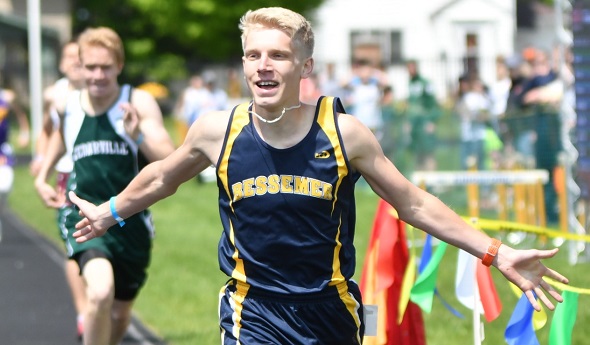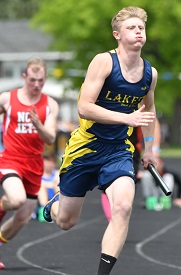
Record-Setter Leads Bessemer Repeat
June 1, 2019
By Adam Niemi
Special for Second Half
KINGSFORD - Bessemer earned its name.
How could the aptly named Speedboys, whose logo is a winged shoe, not win a track & field meet?
They did just that Saturday at Kingsford High School's Flivver Field.
Bessemer's 136 points were enough to comfortably win its second straight UP Division 3 Finals after taking second place in 2017.
Lake Linden-Hubbell was second this time with 67 points, edging Brimley by a point for the runner-up spot.
"They've done excellent. We have done well for the past few years," Bessemer coach Tracy Rowe said. "We took first place last year, lost by four points the year before. They're a really dedicated group of boys.
“A lot of it starts with these kids in cross country, basketball, football. They're just really good athletes. It's just not one person. You can have one student or one athlete and you're not going to win. Of the 13 who made it, all of them except two or three were doing four events. That's phenomenal. They're multi-talented."
Rapid River took fourth with 60 points, and Powers North Central was fifth with 42.
Bessemer's Uriah Aili set Division 3 UP Finals records in the 800, 1,600 and 3,200.
Aili's 800 was timed at 1:59.93, beating his own record (2:01.08) from 2018.
He set the 1,600 record with a time of 4:28.68, five seconds faster than Cedarville's Thomas Bohn ran in setting the previous record in 2018.
 Aili's 3,200 time was 10:08.51. Wakefield's Ryan Holm had set the record in 2001 at 10:10.06. Aili’s 3,200 time may have been even better had he not run the 800 shortly beforehand.
Aili's 3,200 time was 10:08.51. Wakefield's Ryan Holm had set the record in 2001 at 10:10.06. Aili’s 3,200 time may have been even better had he not run the 800 shortly beforehand.
"The 800 took some of the wind out of me," Aili said. "This is my last day of high school running. It's definitely a good way to end. This means the world to me. We have such a small school, and the younger kids look up to me. Now they know what's possible."
Jamie Jett gave the Speedboys wins in the 110 and 300 hurdles. He also took fourth in the 200 and fifth in long jump.
Bessemer won the 1,600 and 3,200 relays.
"Have fun. We told them have fun, do your best," Rowe said. "If you do your best, things will fall where they should fall. You can kind of look at where the seeds are. We've had years where everything has gone wrong. A few years ago a person trips on the hurdles, and someone else sprains an ankle the week of. Keep healthy, do your best, work as a team and support each other."
Lake Linden-Hubbell won the 200 and 400 relays. Stephenson's Montell Glover won the 100 dash. Powers North Central's Leo Gorzinski won the 200. Ontonagon's Noah Lukkari won the 400 with a 52.56.
Lake Linden-Hubbell's Cole Gregorie won the high jump at 6 feet. He also won the long jump at 19 feet, 9 inches.
Bessemer's Zach Baross won the pole vault, and teammate Tyler Busch won the shot put at 47-5.50. Rapid River's Gunner Larson won the discus at 141-4.
PHOTOS: (Top) Bessemer's Uriah Aili wins the 800 on Saturday, one of three individual victories for the Speedboys standout. (Middle) Lake Linden-Hubbell's Kellen Klein carries the baton for one of his team's two relay winners. (Photos by Cara Kamps.)

Track Gaining Speed Toward Future with Electronic Starting Devices
By
Steve Vedder
Special for MHSAA.com
May 23, 2023
Aubrey Greenfield thinks it might be the perfect time to reevaluate 130 years of tradition.
For a number of reasons, from technical to personal, the Oxford senior sprinter believes it makes sense for the crack of a starting pistol to be eliminated from high school track meets.
Because track meets would benefit in various ways from lowering costs to easier setup at meets to the human factor of competitors not having to flinch at the crack of a pistol shot, Greenfield believes the sport has a chance to embrace new technology – electronic starting devices (ESD).
In essence, an ESD replaces the starting pistol with a light flash, tone sound or both to begin a race.
"High school sports should put the athlete first," Greenfield said. "We should promote sports, and eliminating starting pistols promotes health in terms of PTSD or trauma for athletes and spectators and that would be good. I would like to think people would say that's a good idea."
In fact, Greenfield would go as far as to say if there was not an implementation of electronic starting devices, many of her teammates would have considered giving up the sport.
"If it's something that helps us compete safely, we're all for it," she said.
Greenfield's opinion apparently is spreading. Michigan High School Athletic Association senior assistant director Cody Inglis said the use of ESD makes it both affordable for meet starters and sensible for athletes and fans to rethink the use of starting pistols. While the MHSAA is not mandating electronic starting devices, it does promote the use of what Inglis calls "emerging technology." He notes that ESD are becoming the norm for organizations such as USA Track & Field, the NCAA and an increasing number of high schools.
 "I think we have to embrace new technology, and we think this will be something that takes hold," Inglis said.
"I think we have to embrace new technology, and we think this will be something that takes hold," Inglis said.
A key part of embracing ESD is the human element. The tragic Oxford High School shooting Nov. 30, 2021, that took the lives of four students while injuring seven others should not be relived even for a fleeting instance at a high school sporting event. Oxford athletic director Tony DeMare said the school began using ESD at every meet, including the MHSAA Lower Peninsula Division 1 Finals last June. He said that decision was embraced by virtually all schools Oxford encountered.
"We were very convinced that the alternative (of ESD) would promote a healthy attitude," DeMare said. "We were overwhelmed with the positive response. If a school was on the fence about it or might not be for it, I think we've started to see the tide turn in favor of people willing to listen and learn about electronic starting devices."
Inglis said the MHSAA is acutely aware of what the crack of a starting pistol can mean to athletes and fans.
"It's unimaginable what Oxford went through, and this is a small way we can help," he said. "We look at a (starting pistol) and think, ‘Could we do something else?’ It's a way of helping to solve a problem."
Over the last several years, the MHSAA has embraced finding an alternative to starting pistols. Inglis noted the discussion started with the cost and diminishing availability of 32-caliber ammunition that meet starters use. A box of ammunition, if it can be found, is around $75 a box.
In addition to cost, there is potential damage from excessive exposure to 150-plus decibels of sound generated by the traditional 32-caliber blanks. Medical studies show damage to ears caused by decibel levels above 120 dB.
The tragedy at Oxford accelerated the conversation.
Inglis said the cost of ESD can be likened to a school sinking money into artificial surfaces at football fields. Yes, there is a great cost at first, but over time money is ultimately saved. An ESD system itself ranges between $200 and $500. Speakers also may need to be purchased, but with ESD starting events like the 800 and 1,600-meter relays positioned near the outside lanes 8, 7, 6 and 5 would result in improved hearing by athletes at the start of a race.
There is one challenge with ESD that track administrators are working to overcome – lighting conditions that lessen the ability to see the ESD’s LED light or strobe when the button is pressed by a starter to begin a race. But that vision difficulty resulting from clear blue skies and backgrounds of setting suns can be substantially improved by incorporating a black background with an ESD – something as simple as a starter holding up black cardboard behind the lighting mechanism at the start of an event.
Inglis said when all factors are considered, the use of ESD makes sense.
 "With the climate we live in nowadays, no lookalike guns is good," he said. "We're not mandating this. But people are saying this is affordable."
"With the climate we live in nowadays, no lookalike guns is good," he said. "We're not mandating this. But people are saying this is affordable."
While switching to ESD would break 130 years of tradition, the timing could be a step forward, said Jeff Hollobaugh, co-author of the book "The Fleet Feet of Spring: Michigan's High School State Championships in Track & Field." He said while no definitive answer is possible, it's likely starting pistols were used at the inaugural state meet at the Jackson Fairgounds in 1895. The meet, which included events like tossing a 16-pound shot put, bike races and a 100-meter sprint, was sponsored by the Michigan Interscholastic Athletic Association (a predecessor to the MHSAA) and comprised mostly of the state's larger schools.
Hollobaugh's sentiments echo what many involved in today's high school track & field believe in terms of making a transition from starting pistols to electronic starting devices.
"It's a change, not necessarily good or bad, just different," he said. "It's not a drastic change, but it will take some getting used to. But it is the future. In the end, we'll all be fine."
DeMare believes the future of high school track will definitely include ESD.
"Our desire is that the practicality and sensibility of this will overcome the alternative," he said. "I think we'll see the automation and electronics taking hold of certain elements in track, and people will embrace it."
PHOTOS (Top) Runners watch official Bertha Smiley as they prepare to begin a race during last season's Lower Peninsula Division 1 Finals at Rockford. (Middle) An electronic starting device provided by VS Athletics was used to start those races. (Below) Smiley sets to begin an event. (Photos provided by David Kuderka/VS Athletics.)

